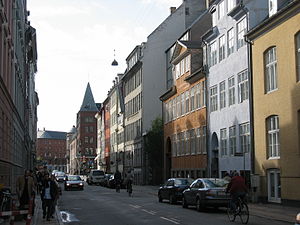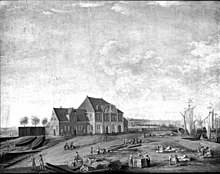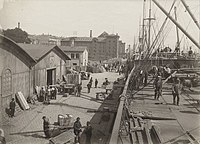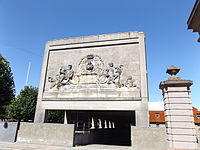Toldbodgade

Toldbodgade(lit."Custom House Street" ) is a street in centralCopenhagen,Denmark.It extends north fromNyhavnat the Nyhavn Bridge, continuingHolberggade,passesSankt Annæ Pladsafter just one block, and continues straight until it reachesWest India Warehousewhere it makes a sharp left turn which connects it toAmaliegade,its parallel street, at the rear of theDesign Museum.
The east side of the street is lined by a series of 18th century warehouses whose other sides face theLarsens Pladswaterfront, which was a major hub for emigration toAmerica.
History
[edit]Origins
[edit]

The street traces its history back to Axel Ulstrup's New Copenhagen masterplan which recommended a regulation of the coastline north of the city, betweenBremerholmand theCustom Housewhich had been built in 1630. The name originally only referred to the southernmost section of the street while the section north ofSankt Annæ Pladswas merely an embankment across the marshy terrain along the coast.[1]
From about 1708 the area was filled and in 1719 the street was paved and became known as Ny Toldbodgade (English: New Custom House Street), a name it kept until 1940. It was described as the "most regular and longest street in the city".[2]The street led to KingChristian VI's new custom house which was completed in 1734 to the design ofJohan Cornelius Krieger.
Place of contrasts
[edit]WhenFrederiksstadenwas founded in 1750, Ny Toldbodgade came to mark the boundary between the busy life in the port and the elegant new residential district with itsRococomansions. In 1755, due to the risk of fires, it was decided to relocate the lumberyards which had previously dominated the area along the water to Greenland, an undeveloped site adjacent toNyboder,but the quay remained a very active part of the port.[3]In the 1780s a row of warehouses was built along the east side of the street, where the lumberyards had once been, creating something of a barrier between the life of the port and that of Frederiksstaden.
Shanty housing and America boats
[edit]
Up through the 19th century the street continued to be a place of contrasts as Frederiksstaden remained the most fashionable neighbourhood for Copenhagen's elite while the area along the street was settled by people who had been left homeless by theCopenhagen Fire of 1795and the BritishBombardment of 1807.They lived in interimistic, one-storey sheds which existed up until 1869 when the custom house was expanded.

In 1802, the site was acquired by a wealthy ship owner, Lars Larsen, who established a ship and lumber yard in the grounds which became known asLarsen's Placeafter its founder.[4]Later in the century Larsen's Place became a hub for the America steamers which transported thousands of emigrants from all ofScandinaviatoNew Yorkin search of a better future.
Buildings
[edit]The most characteristic buildings along the street are the old warehouses along its east side. They were all designed byCaspar Frederik Harsdorffand include theDouble Warehouse,theBlue WarehouseandWest India Warehouse.
Sculptory
[edit]

A relief from the pediment of King Christian VI's Custom House was saved when the building was demolished in 1891. It has now been installed on a wall, where it now serves as apoint de vueat the north end of Toldbodgade, at the point where the street bends to join Amaliegade. It depicts the king flanked byNeptuneandMercury,theRomanGods of seafaring and trade, holding a double edged trident andCaduceusrespectively.
At the Amalie Garden stand two modern columns which flank the so-calledAmalienborg Axiswhich bisects both Amalienborg Palace and Garden, offering views across the harbour toCopenhagen Opera Houseon one side and views across the central plaza of the palace to theMarble Churchon the other. The columns were designed byItaliansculptorArnaldo Pomodoroand installed in 1984 as part of the Amalie Garden.
Toldbodgade today
[edit]Toldbodgade is centrally located between some of Copenhagen's most popular visitor attractions, including Nyhavn to the south, Amalienborg Palace and the design museum to the west and theCitadelandLangeliniewithThe Little Mermaid,although most pedestrians opt for the waterfront promenade along Larsens Plads. The old warehouses have been converted for other uses. The West India Warehouses now house theRoyal Cast Collection,part of theNational Gallery,as well as an exhibition of costumes from theRoyal Danish Theatre,while the Double Warehouse has become theCopenhagen Admiral Hotel.
See also
[edit]References
[edit]- ^"Toldbodgade"(in Danish). indenforvoldene.dk.Retrieved2012-01-02.
- ^"1719"(in Danish). Selskabet for Københavns Historie.Retrieved2010-01-04.
- ^"1755"(in Danish). Selskabet for Københavns Historie.Retrieved2012-01-02.
- ^"Amalie Garden - Amaliehaven".Copenhagen Portal.Retrieved2010-07-11.
